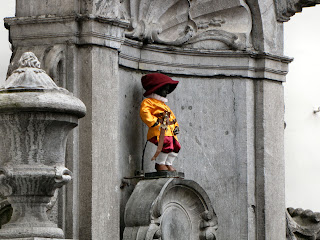This is day 11, the second week of solitary confinement with a toddler and an infant while my husband is abroad. Everyone is still alive.
Lauris has run over Mikus once with the scooter, once with the tricycle, and once with a chair when I had taken the first two away. He has climbed out of his bed 231 times (calculated by multiplying yesterday’s count by 11). He has spilled his juice, dropped his ice cream, and gone digging in the kittie litter box.
Mikus has started to crawl, more like inchworm his way across the floor. He has slept less than ever, waking up earlier, staying up later. This could be due to the heatwave but probably has more to do with his brother giving him a wake-up-call (a lion’s roar right in the ear) when he does fall asleep. An infant, acting alone, has produced two monster loads of laundry.
Me? I have cried out of frustration, anger, fatigue and for no reason at all. My showers consist of one minute affairs as I try to keep Lauris away from Mikus, and Mikus from screaming away those last shreds of my patience. I am on a great diet; it’s called I don’t have time or the energy to eat. And when I do get out of the house it’s a free ticket for both boys to become unmanageable, for passers-by to give me ‘that’ look (the “my children never act like that,” “how can she leave the house,” “évidemment une femme américaine” look). I would love to eat a meal uninterrupted or go shop some of the soldes; but I will settle for washing my hair.
This is me in 2003. It was my last year earning my degree in forestry at University of Illinois
I wish I could recapture this moment, as it is probably the last picture taken of the old me, the care-free girl with a smile on my face and the axe in my hands. I was tough! I didn’t win the speed chop that day, but I finished and set a personal best. This picture represents the girl who would become a wildland firefighter, dreamt of hiking the Appalachian Trail and was convinced Alaska France
These days I have a harder time finding that girl in the person I am now. Some things haven’t changed since my forestry/firefighting days (two weeks without a real shower) but mostly my life is the opposite of those days ten years ago. I’m washing my laundry not to get the sweat and blood out, but to wash the spit-up off. I’m not buckling myself into a harness to hang out of a helicopter; I’m buckling two squirming noodles into car seats. And I’m having a hard time feeling “tough” when a mere two weeks sans husband have me wrecked.
* Thanks to Russell Ward at In Search of a Life Less Ordinary: Adventures in Making a Home Away from Home, for hosting the No More Bad Photos competition.
** Update 07/02/2012
This essay took first place in the In Search of a Life Less Ordinary competition! Here's the announcement, and a huge thanks to Russell and his wife for awarding me this honor (and the awesome prize of a new Sony camera)!
This essay took first place in the In Search of a Life Less Ordinary competition! Here's the announcement, and a huge thanks to Russell and his wife for awarding me this honor (and the awesome prize of a new Sony camera)!








































